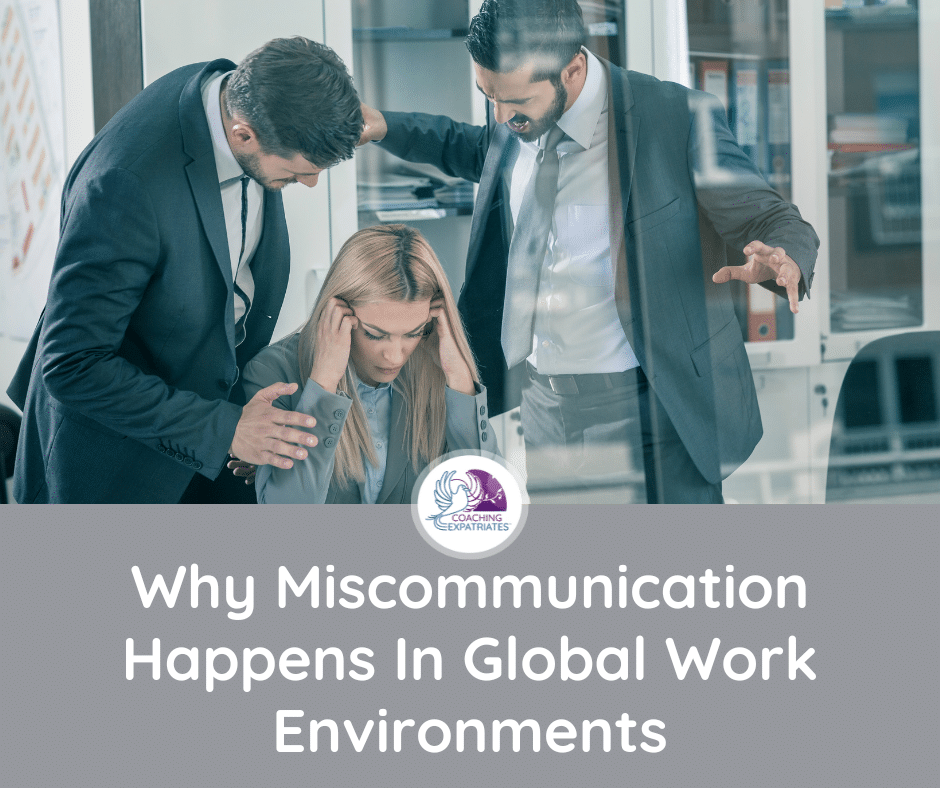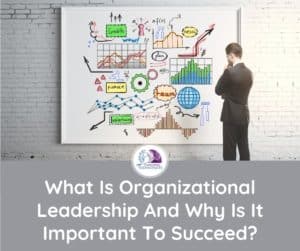Have you ever argued with someone or found yourself in a confusing conversation that made you agitated? Miscommunication is an unavoidable part of life and more so in global leadership, but why does it happen so often? From casual conversations to professional meetings, miscommunication can have serious consequences. Understanding how and why miscommunication occurs can help us become better communicators and ensure we don’t fall victim to its effects. In this article, I will explore the cost of miscommunication, the types of communication that can lead to it, the 10 main reasons why they happen, and how to avoid them.
The Cost Of Miscommunication
Miscommunication can have serious consequences, with the cost varying depending on the situation. In professional settings, miscommunications can be costly in terms of both time and money. Misunderstandings between colleagues can lead to delays in completing tasks, while disagreements between departments can result in expensive and unnecessary rework. In personal relationships, miscommunication can lead to confusion, hurt feelings, and resentment. When communicating with friends or family members, miscommunication can lead to arguments and a breakdown in trust.
In global leadership, it’s customary to calculate the cost of miscommunication by multiplying the hourly pay of people involved in a miscommunication, times the number of hours of rework generated by the process. On top of this amount, it’s added all the unnecessary extra costs generated by the miscommunication, like any extra fees, late fees, lawsuit payouts, lawyer fees, and so on. It’s estimated that one simple misunderstanding can generate 5 times more unnecessary costs than it should.
Miscommunication can cost companies millions of dollars per year. A survey of 400 companies cited an average loss per company of $62.4 million a year due to communication blunders. These issues can happen across many fields, but this article will focus on miscommunication in business.
In addition to these direct costs, indirect costs are associated with miscommunication, such as stress, anxiety, lack of focus, lack of innovation and motivation, loss of credibility, and a decrease in morale. A basic understanding of how miscommunication occurs is the first step towards minimizing its impact on our lives.
Miscommunication can have far-reaching and costly effects, making it important to be mindful of how we communicate with others if we want to ensure the highest company profitability possible. To prevent misunderstandings and ensure successful interactions, consider the different types of communication available and choose the one that best suits the situation’s needs.
Types Of Communication
There are many different types of communication that can be used to convey a message. Knowing which type to use in any given situation is important for successful communication.
Verbal communication involves the spoken word, and includes face-to-face conversations, telephone calls, video conferencing, and online chat rooms. Written communication, which is a form of verbal communication, uses words on paper or a computer screen or technological device to communicate ideas or send messages. It could include emails, letters, text messages, or even physical notes made by a printer.
Nonverbal communication relies on body language, facial expressions to convey messages without words, and paralanguage, which is how speech is employed through articulation, tone, accent, and pitch.
Lastly, visual communication uses signs and images, such as diagrams or charts, to help explain complex topics or illustrate data points.
Read our in-depth article on the different styles of communication to learn more about the communication styles and types used by global leaders.
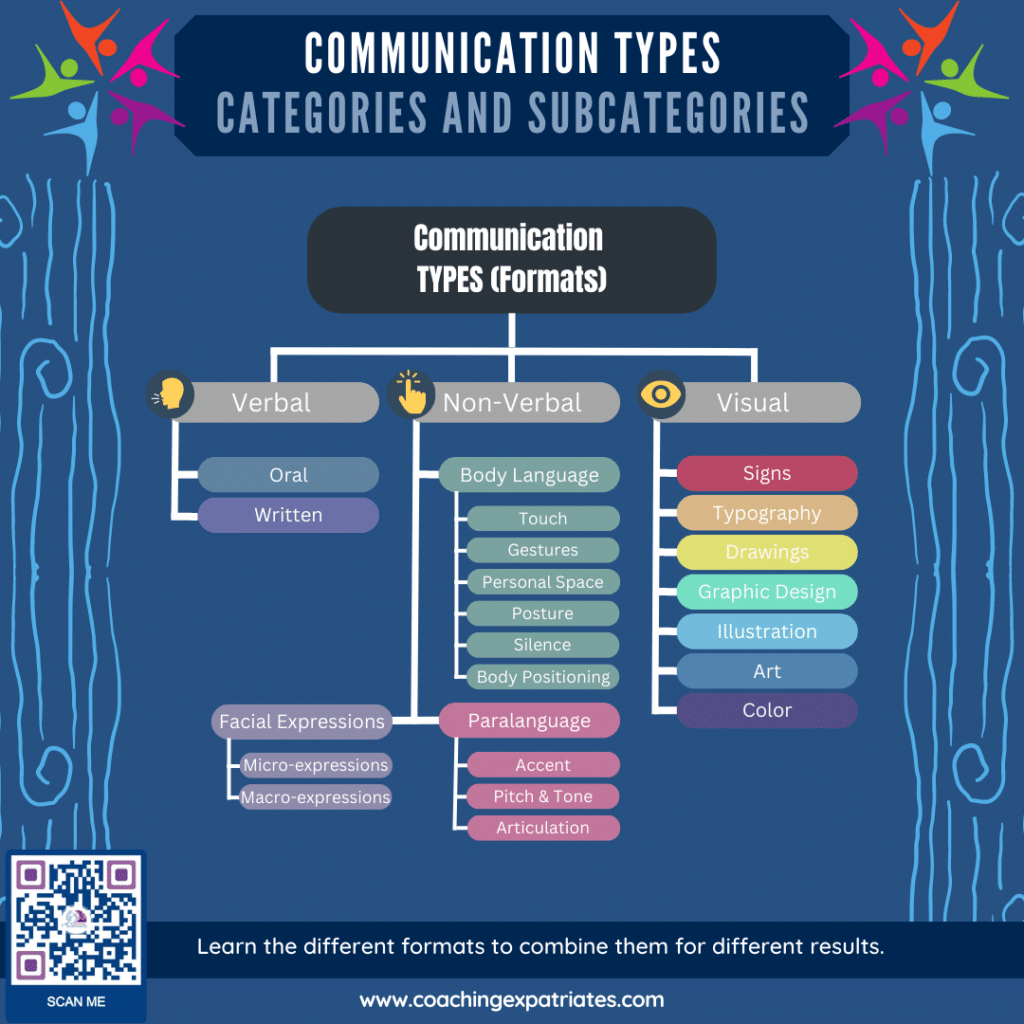
When communicating with others, it’s important to consider the context of the conversation and choose the form of communication that best suits the situation. Research shows that different cultural contexts require different approaches.
Each type of communication has its own advantages and disadvantages – oral communication may offer more flexibility than written communication, while written communication might provide greater accuracy than oral ones. This is one of the reasons why we always recommend global leaders provide written instructions once a verbal task or assignment is given, especially if those involved in the interaction have different mother languages.
Being aware of these differences in the types and uses of communication can help ensure successful interactions through messages that are effectively communicated and understood. Next, we’ll explore some of the communication models that we naturally use!
Models Of Human Communication
Models of Human Communication are used to explain how communication works between two people or within a group. These models provide insight into communication components, such as sender, receiver, message, and feedback. They can also be used to analyze the thinking patterns of people and develop strategies for effective communication.
The most common model is the Linear Model of Communication, which suggests that communication is a one-way street; information flows from the sender to the receiver in a linear fashion. This model emphasizes the importance of explicit, precise language, and key listening skills like active listening to ensure that messages are accurately conveyed and understood. This model is often used by teachers, trainers, speakers, and people in authoritative positions.
Other models include the Transactional Model, which suggests that communication is a two-way process where both parties send and receive messages simultaneously. This model is what we mostly use in our regular interactions on a daily basis during conversations.
The Symbolic Interactionism Model focuses on how symbols play an important role in understanding meaning when we communicate with each other. This model is used by a variety of individuals and groups, including sociologists, communication scholars, psychologists, educators, and researchers in various fields. It’s particularly useful for those who are interested in understanding how people create and negotiate meaning through their interactions with others in everyday life. In addition, this model can also be applied to various contexts, such as interpersonal relationships, group dynamics, organizational communication, and media and marketing studies.
Lastly, there’s the Circular Model, which suggests that meaning is created through the interaction between participants in a conversation rather than simply passing one-way information from sender to receiver. Employing this model requires advanced skills in communication from its users, as it demands attention to cues, body language, paralanguage, and words from various sources, and, possibly, different cultural contexts at once.
No matter what model we use, effective communication requires careful consideration of all components involved, including body language, tone of voice, clarity of language, and ensuring everyone has a chance to participate in conversations without interruption.
You know what communication models exist and what are the key communication types, so you have a baseline to understand the main causes of miscommunication, which is what we’ll explore next.
10 Reasons Why Miscommunication Happens In Global Work Environments
There are many reasons for miscommunication to happen, of course, but I listed below the main reasons they can occur in a multicultural corporate environment. Here they are:
- Assumptions: we wrote an entire article about the dangers of assumptions. Assumptions are one of the hottest spices for miscommunication. It’s easy to overthink and create stories in our heads that are entirely misleading and lead to misunderstandings. Assumptions often happen when we are in a different cultural context than ours, or when we lack the context to understand what is really going on. Limited feedback is another common problem in the workplace, which leads to employees making assumptions that are often not true. Quick conversations and clear feedback can help bridge gaps and clear assumptions.
- Negativity Bias: also known as the negativity effect, negativity bias is when negative information in one’s life has a higher weight and impacts their psychology more than positive ones. It’s our tendency to dwell on negativity and even expect it. It’s the perfect hot spice paired with assumptions to create miscommunication. If your fiance calls you saying he “can’t make it tonight,” the misunderstanding can be created by the negativity bias of you thinking that he is probably doing something illicit with someone else instead of coming to see you. Your conversation will lean towards a biased path which is bound to misunderstanding. This is an example of the association between negativity bias and assumptions. In a corporate environment, something very similar can happen when your boss suddenly takes you out of a project without much context. Whenever we feel rejected, negativity bias can be strongly triggered, although not exclusively, and our reactions are what lead to miscommunication.
- Unclear Expectations: whenever we have unclear expectations, we think and do whatever we think it’s best in that situation. Our brains must all fill in the gaps in our cognitive process. This means whenever we are not actively managing people’s expectations, they’ll create their own, which might differ from the actual situation or context, leading to miscommunication. People who have unclear expectations also pass messages with less care and purpose, which might cascade miscommunication. That’s why you want to provide clear expectations to your team members, so they can also confidently pass on your communication, without any Chinese Whispers effects.
- Lack Of Trust: if you start a conversation on the wrong foot, clearly miscommunications might happen. If this is topped by a lack of transparency from the part you already lack trust, this might even lead to a greater form of miscommunication called conflict. Not all conflicts stem from miscommunication, of course, but many are and would have been easily avoided if the Trust factor was established first through trust-building skills. This might sound strange, but trust building is a part of the communication skills arsenal. That’s why many communication trainings over-emphasize the importance of building rapport: because establishing a connection and a foundation for trust is crucial for any communication.
- Jumping The Gun: sometimes we listen to respond, not to understand. We are so eager to be right, we are anxious to sound clever. Or we are simply eager to give our own opinion to contribute to a discussion. When we are in this type of state, our listening skills are turned off. I once was debating something with my husband, and he started his argument in a way that sounded opposing to my opinion. My negativity bias kicked in, and I started thinking about my next counterarguments instead of listening to what he was saying. I jumped the gun, barely letting him finish when then he said, “Hey, I’m just saying I agree with you!” I felt embarrassed when I finally noticed that I had let my ego get the best of me and was not using my listening skills which I had put so much effort into honing. The closer we are to people, the more prone we are to jump the gun like this. It’s natural to lower our guard when we feel safe, but we have to be even more attentive to avoid miscommunication with our loved ones due to this. The same applies if you are in a very good stance with someone at the office. You might lower your guard with them and jump the gun, creating opportunities for miscommunication.
- Poor Articulation: some complex situations require exceptional articulation of ideas, task coordination, and people management. When we fail to coordinate and express our ideas, the execution, and the people around us, miscommunication that leads to misunderstandings can happen. Poor articulation is frequently viewed as solely a communication problem, when most of the time is also a lack of Organizational Leadership and Business Acumen problem. People who understand their own ideas, how they can be applied, and why, can often make use of average communication skills and still have a great articulation of ideas.
- Wrong Use Of Terms: sometimes people use wrong terms in certain situations that might mean something completely else. Sometimes they do it because they want to look clever, or sometimes the reason is much more complicated: certain terms may mean one thing in one language and something else in another. They are called false cognates or “false brother-in-law.” For example, the term “embarrassed” in English means discomfort, unease, and unsettled. In Spanish, the term “Embarazada” means pregnant. These 2 words seem to be a translation of each other, but they are not. In the 90’s, there was a hilarious Language School TV commercial where a guy says his girlfriend was “embarazada” wanting to say she was feeling uneasy. Her conservative Mexican dad thought she was pregnant from him, creating a huge and hilarious misunderstanding.
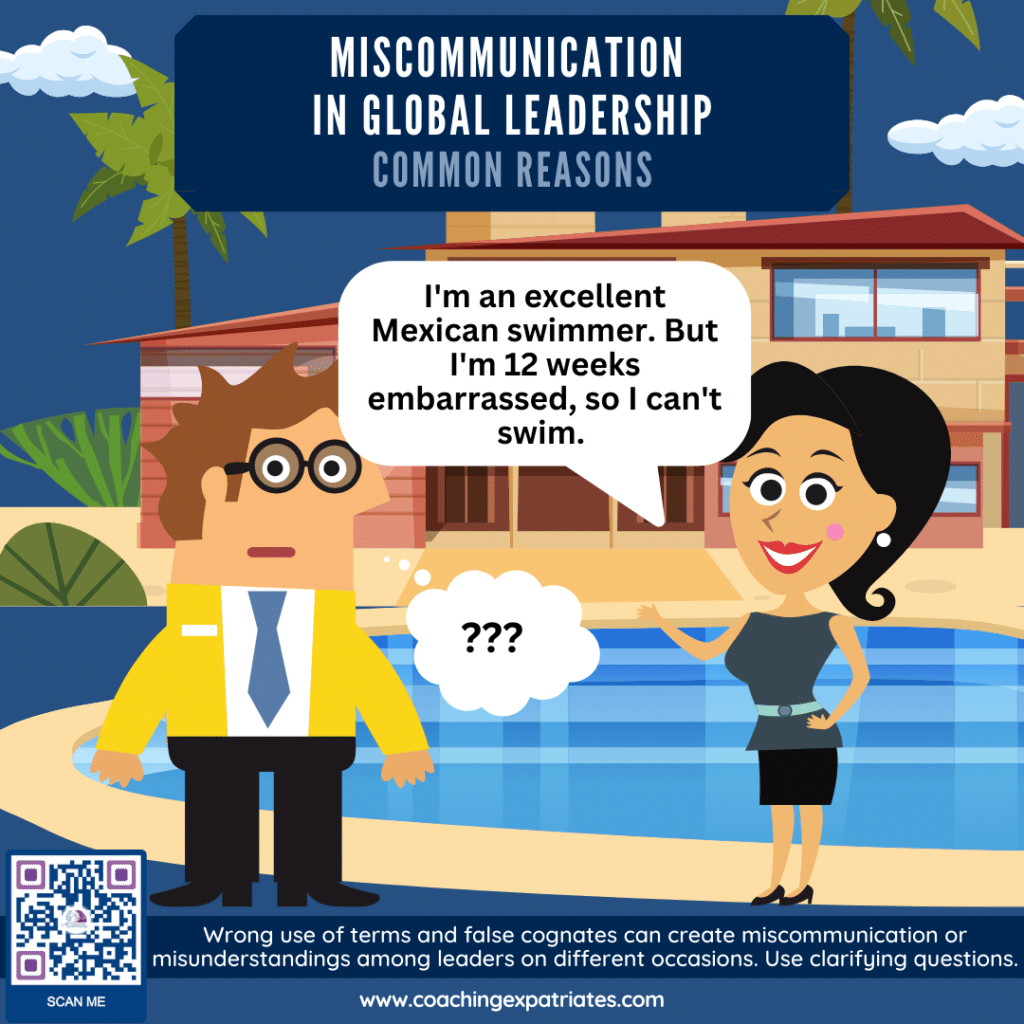
- Misinterpretation: sometimes, even when we do articulate things efficiently and use the correct terms, people might still misinterpret what we are saying. There is very little we can do to avoid misinterpretation except to be diligent when doing our homework: how does the other person consume information? What would be the best format, style, and strategy to deliver this communication? What type of context is necessary for the audience to understand this information? The more we know about who is hearing what we say, the greater the chances of us using their own verbiage to communicate. For example, we usually do this with kids very well. We flex and adapt to delivering specific messages to them in a way they can understand us better. We would say “Papa went to a brain doctor” instead of saying “I went to a Neurosurgeon.” I’m not saying you should be patronizing. You must learn to flex and adapt in a professional way so that your listener can perfectly understand you.
- Poor Mental State: when we are confused, uncertain, and challenged, it’s easier to let the negativity biases and assumptions kick in. Our mental state is an essential factor in communication. Mind you, the same applies to the person we are talking to. If we notice someone is not in a good moment to receive information, even if it is something that sounds innocuous, it’s not ideal to share or ask anything at that time. Remember this next time your spouse comes home tired and frustrated. Being aware and understanding our own mental state and of those around us is a key skill in Personal Leadership, and it’s one of the foundation pillars in The Global Leadership Pillars™ for influential leaders.
- Lack Of Confidence: people confuse this with poor mental state, but they are very different and can have other effects. Even when we are in excellent spirits and disposition, when we lack confidence, the sending and receiving of messages can be impacted. When we lack confidence, we might be less assertive, articulate things more poorly, and even forget to mention important things in the context of the message. When we lack confidence, we also might rush things to get over with them to get rid of the feeling of discomfort. If you ever feel you are lacking confidence when communicating, stop, regroup your thoughts, and find ways to up your confidence game. If you are communicating with someone that lacks confidence, you can coach them through the process with empowering questions that help critical thinking and articulation of ideas. We have special manager coaching classes in our Executive program, by the way, because we feel this is a key skill for any leader.
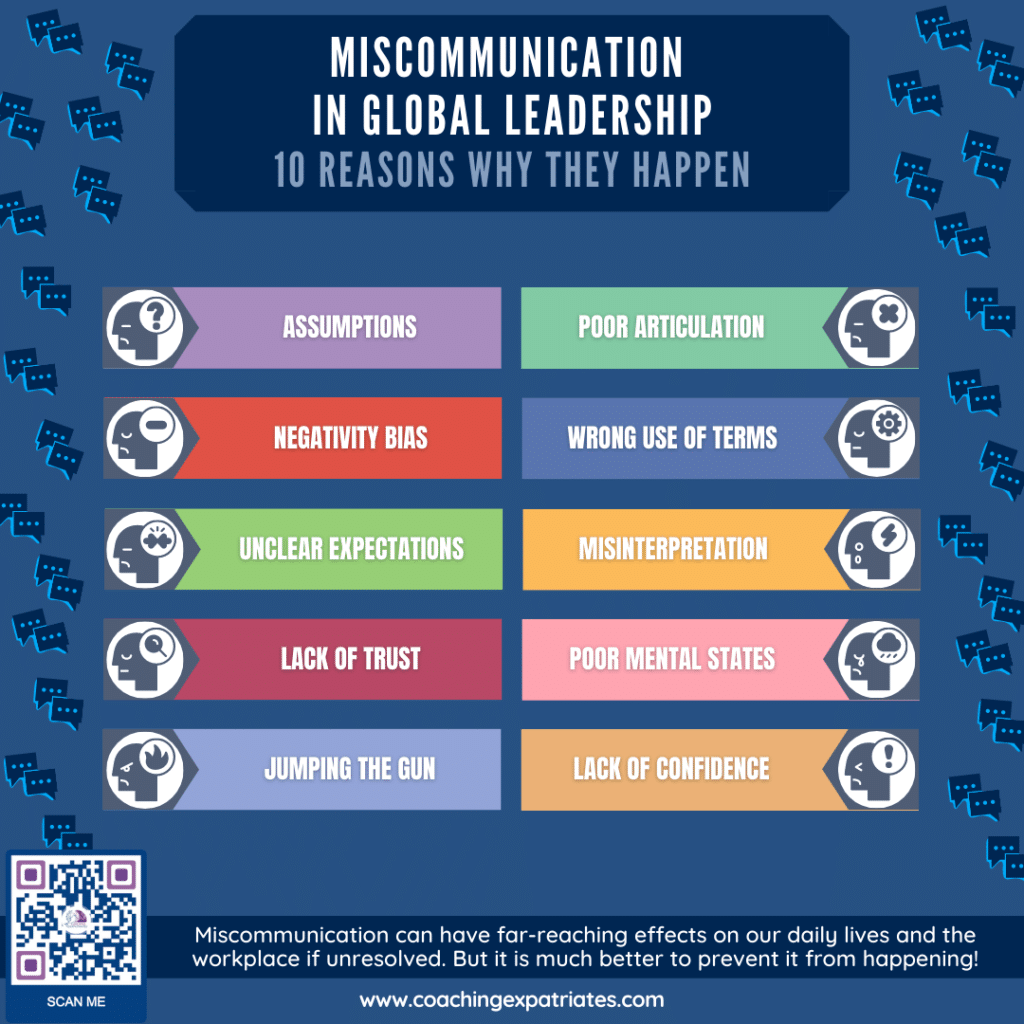
Effects Of Miscommunication On Daily Life
Miscommunication can have far-reaching effects on our daily lives. It can lead to frustration, confusion, and even hurt feelings if it goes unresolved. Awful miscommunications can also cause a breakdown in communication in communities and lead to misunderstandings and disagreements. From the workplace to personal relationships, miscommunication can cause problems that may be difficult to resolve.
The key to avoiding miscommunication is understanding what causes it in the first place and taking steps to prevent it from happening. This means being aware of cultural differences, using clear language when speaking or writing, and actively listening when someone else is talking. Taking these steps will help ensure that everyone involved understands each other and prevents unnecessary misunderstandings.
To avoid the frustration, confusion, and hurt feelings that can come with miscommunication in personal relationships, it’s important to take the time to ensure everyone is on the same page. Communication should be clear and respectful at all times. In the next section, we’ll take a closer look at how miscommunication can affect the workplace.
Effects Of Miscommunication In The Workplace
Miscommunication in the workplace can have severe consequences. It can lead to project delays, missed deadlines, inaccurate information, inefficient workflows, unnecessary extra costs, and even strained relationships between coworkers or entire departments.
I once worked in a department where a coworker started to be secretive and pull people to talk on the side all the time. The only person who was not being pulled made assumptions, jumped the gun and reported his behavior to HR, saying he was “disrupting the culture.” The sad part about this misunderstanding is that the poor guy was actually coordinating a surprise party for the very person who made the report. What was the communication mistake here? The person who felt insecure and wary should have confronted the person to clarify their understanding of what was going on, before taking any extreme action.
To avoid miscommunication in the workplace, it’s important to ensure that everyone is on the same page. Understanding cultural differences and contexts, different motivations and desires, and using clear language when speaking or writing will help establish a firm foundation of mutual understanding. Active listening is also essential to ensure that everyone has the chance to speak their opinion without being interrupted.
Taking the time to establish clear communication channels and objectives for each project is key to preventing miscommunication from occurring in the first place. Regular check-ins with colleagues will help confirm that everybody is on track and up-to-date with progress. Finally, encouraging honest and respectful dialogue or constructive feedback in the workplace will help foster an environment of openness and trust which are essential components of effective communication.
7 Ways To Prevent Miscommunication In Your Interactions
Global leadership involves managing teams, projects, and operations across cultural, linguistic, and geographical boundaries. Effective communication is essential for successful global leadership, as miscommunication can lead to misunderstandings, conflict, and, ultimately, project failure. Here are some strategies that can be used to prevent miscommunication in global leadership:
1. Develop cultural awareness and sensitivity: Different cultures have different communication styles and norms, which fall under their cultural context. Leaders need to be aware of and respect these differences to avoid misunderstandings, and also must be mindful of their own cultural biases and how they might affect communication.
2. Use clear and concise language: When communicating across cultures and languages, it is important to use language that is easy to understand. Leaders should avoid using jargon, technical language, idioms, and colloquialisms that may not be familiar to all their audience. That’s why it’s recommended to be as explicit and precise as possible in the use of words. For example, instead of saying, “This is water under the bridge.” you might want to say, “Let’s leave any differences and grievances behind us.”
3. Confirm understanding: In global communication, it is important to confirm that the message has been understood. Many fear being patronizing, but if you state your intentions, things become clearer to the audience. For example, if you are the sender of the message, you may want to say, “Just to make sure we are on the same page, could you share back your understanding?” And if you are the receiver of the message, you might want to say, “I want to confirm my understanding; let me tell you what I understood.” Leaders should encourage their team members to always ask questions and seek clarification if they are unsure about something but do the same when they do feel they are sure.
4. Use multiple types of communication: In addition to verbal communication, leaders should use other modes of communication such as email, instant messaging, and video conferencing. Using multiple communication modes can help ensure everyone is on the same page. One recommended strategy in global leadership is to have a quick phone call or virtual call, and then summarize the main points discussed in a written format, like email, right after, asking if any topics differ from their understanding. Fine-tuning common understanding is critical. Be mindful of preferences. Not everyone loves instant or text messages as the main written communication mode. Learn the preferences of your key stakeholders, including your team members.
5. Establish clear communication protocols: Leaders should establish clear communication protocols, such as meeting agendas, email response times, and communication channels. This is also called “managing expectations,” a crucial skill in global leadership. This can help ensure that everyone knows what is expected of them and when they should communicate or do things. It’s been shown that people who know what they are expected of perform many times better at work than those who don’t because they don’t lose internal process time pondering what to do next.
6. Provide training and resources: Leaders should provide their team members with training and resources on effective communication across cultures. This can include language training, cultural sensitivity & competence training, cultural immersion opportunities, and communication best practices. If everyone on the team has a similar level of cultural awareness and competence, the team interactions become more fluid and seamless, and with a lesser degree of conflict opportunities.
7. Create rules of engagement: teams with clear and written rules of engagement are shown to move from storming to performing much faster. These rules establish key things each team member is expected in terms of behavior, conduct, and general response on a regular basis. Rules of engagement are essential not only for team members but also the leaders. And that’s because the rules of engagement must also include what’s expected of the leader. For example, I once worked in a place where the rules of engagement stated that the leader would not set meetings for off-hours in the time zone of the joint participants, except in extreme cases, which should then be agreed upon beforehand with at least a week’s notice time. The best rules of engagement I’ve seen were written by all team members together. It’s usually done in a team-building event for this sole purpose.
By following these strategies, global leaders can help prevent miscommunication and ensure that their teams are working together effectively across cultural and linguistic boundaries.
Final Remarks On Why Miscommunication Happens In Global Work Environments
In conclusion, miscommunication happens for a variety of reasons in global teams, such as differences in culture, language, communication preferences, and expectations. To prevent miscommunication, global leaders should use multiple types of communication, establish clear communication protocols, provide training and resources to their team members, and create rules of engagement. By following these strategies, leaders can ensure that their teams are working together effectively while immersed in a healthy and profitable workplace.
If you are looking for a leadership development partner and consultant to help you implement some of these ideas, you can hire me as your executive and development coach. Have a Free Strategy Call with me. We will go over your communication needs, and devise together the top priority skills to develop and start practicing them together.
If you are interested in developing specific global leadership skills, personally or team-wise, check out our online Global Executive Leadership Program. We go over all The Global Leadership Pillars™ during 9 online modules, specially meant for global leadership development. It’s a unique leadership training methodology that will change the way you think, relate, and strategize as a global leader.
If you enjoyed this post, consider subscribing to our newsletter using the form below. We focus on providing good content to global leaders and executives who want to make impactful business decisions and be more inclusive and influential. We know your inbox is sacred, so we email just once per week, and we never sell, rent or do anything funky with your information. Trust is the basis of Global Leadership, and we fully honor it.

